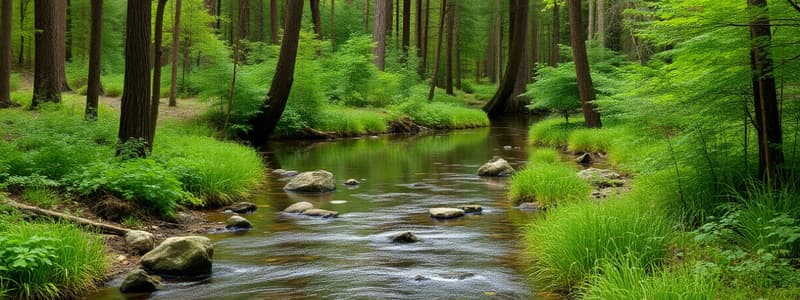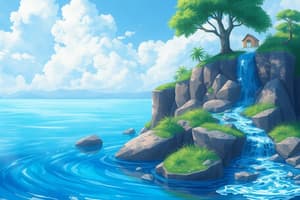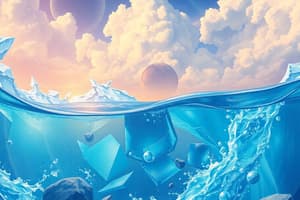Podcast
Questions and Answers
State the three different states of matter in which water can exist.
State the three different states of matter in which water can exist.
Solid, liquid, gas
Which of the following is NOT a major water store?
Which of the following is NOT a major water store?
- Glaciers
- Rivers
- Atmosphere
- Volcanoes (correct)
Transpiration is the process of water moving from the ground to the atmosphere through plants.
Transpiration is the process of water moving from the ground to the atmosphere through plants.
True (A)
A water budget is a balance between water ______ and ______.
A water budget is a balance between water ______ and ______.
Describe two ways in which forests are used by humans.
Describe two ways in which forests are used by humans.
Match the following forest adaptations with their corresponding function:
Match the following forest adaptations with their corresponding function:
Which of the following is a consequence of extracting materials from forests?
Which of the following is a consequence of extracting materials from forests?
Suggest one method for sustainably managing tropical rainforests.
Suggest one method for sustainably managing tropical rainforests.
Flashcards
States of Water
States of Water
The three forms of water: solid, liquid, and gas.
Water Cycle Steps
Water Cycle Steps
Processes include evaporation, condensation, precipitation, and runoff.
Water Budget Definitions
Water Budget Definitions
Comparison of water input and output, resulting in surplus or deficit.
Floods
Floods
Signup and view all the flashcards
Droughts
Droughts
Signup and view all the flashcards
Uses of Water
Uses of Water
Signup and view all the flashcards
Tropical Rainforest Characteristics
Tropical Rainforest Characteristics
Signup and view all the flashcards
Sustainable Forest Management
Sustainable Forest Management
Signup and view all the flashcards
Study Notes
Water and Water Cycle
-
States of Water: Water exists as a solid (ice), liquid (water), and gas (water vapor).
-
Water Stores: Water is stored in various locations including glaciers, groundwater, lakes, and oceans.
-
Hydrologic Cycle: The continuous movement of water through the environment, including precipitation, groundwater flow, surface runoff, evaporation, and transpiration. Condensation is also part of this cycle.
-
Water Budget: The balance between water inputs (e.g., precipitation) and outputs (e.g., evaporation/transpiration) determines if there's a surplus or deficit. A surplus occurs when inputs exceed outputs, and a deficit when outputs exceed inputs.
Water Issues
-
Floods: Result from the overflow of large bodies of water.
-
Droughts: Occur when an area receives very little rain over an extended period of time.
Water Use
-
Agriculture: Uses the most significant amount of water.
-
Industry: Uses water for cooling machinery.
-
Domestic: Uses water for tasks like showering and laundry.
-
Recreation: Uses water for activities like water sports (least used).
Tropical Rainforest (TRF)
-
Location: Primarily near the equator.
-
Characteristics: Evergreen forest with distinct layers (emergent, canopy, undergrowth).
-
Adaptations: Drip tips, broad leaves, waxy leaves, and buttress roots (to cope with high rainfall and humidity).
Mangroves
-
Location: Coastal areas, often in sheltered environments.
-
Characteristics: Lower plant diversity compared to TRFs, with horizontal layers.
-
Adaptations: Salt-secreting leaves, aerial roots, and salt-extruding root systems, allowing these trees to survive in saline conditions/water.
Forest Uses
-
Habitation: Forests provide places for people to live.
-
Food: Forests are a source of food.
-
Raw Materials: Forests provide raw materials for various products.
-
Recreation: Forests offer opportunities for recreation.
Forest Impacts/Management
-
Deforestation: The removal of trees from forests.
-
Greenhouse Effect: Activities that lead increased levels of greenhouse gases in the atmosphere.
-
Sustainable Management: Practices like rehabilitating disturbed areas, promoting education, regulating forestry activities, and establishing protected areas can help maintain forests sustainably.
General Skills (Short Answer)
-
Identification: Identifying a subject or item. (1 mark) [Example]
-
Calculation: Mathematical problems requiring a calculation. (1 mark) [Example]
-
Suggestion: Recommendations or ideas based on knowledge. (1 mark) [Example]
-
Description: Providing a detailed account of a topic or item, with explanations. 2 marks [Example]
-
Comparison: Identifying similarities and differences between two items or subjects. 2 Marks[Examples:
-
A and B are similar.. for example..]
-
A and B differ, For example..]
-
Explanation (with Graph): Analyzing data, explaining findings with reference to graphs, including: Point, Explanation, and Connection to the graph. 3 marks
-
Evaluation: Assessing positive and negative points about a subject.(e.g., Good/Bad example of something), Advantages/disadvantages of a subject, or concept, including examples.
Studying That Suits You
Use AI to generate personalized quizzes and flashcards to suit your learning preferences.




